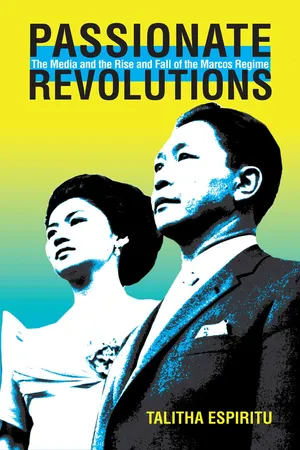![]()
Notes
Introduction: The Power of Political Emotions
1. Lauren Berlant’s work on “public feelings,” “intimate publics,” and “national sentimentality” is very relevant to my project. See esp. Berlant, “The Epistemology of State Emotion,” in Dissent in Dangerous Times, ed. Austin Sarat (Ann Arbor: University of Michigan Press, 2005), 46–78.
2. Deborah Gould provides a useful genealogy of this anxiety from within the field of sociology. See Gould, “On Affect and Protest,” in Political Emotions: New Agendas in Communication, ed. Janet Staiger, Ann Cvetkovich, and Ann Reynolds (New York: Routledge, 2010), 18–44.
3. Lauren Berlant, “The Subject of True Feeling: Pain, Privacy, and Politics,” in Cultural Pluralism: Identity, Politics, and the Law, ed. Austin Sarat and Thomas R. Kearns (Ann Arbor: University of Michigan Press, 2001), 49–84. See also Berlant, The Female Complaint: The Unfinished Business of Sentimentality in American Culture (Durham: Duke University Press, 2008).
4. Berlant, “Epistemology of State Emotion,” 51, 49, 54.
5. See Joyce L. Arriola, “Scripting the Filipino Story through Media Images: Official and Popular Notions of Nation during the Marcos Years,” Pilipinas: Journal of Philippine Studies 44 (2005): 33–48; Rolando B. Tolentino, “Marcos, Brocka, Bernal, City Films and the Contestation for Imagery of Nation,” Kritika kultura 19 (2012): 115–38.
6. Jonathan Beller, Acquiring Eyes: Philippine Visuality, Nationalist Struggle, and the World-Media System (Quezon City: Ateneo de Manila University Press, 2006).
7. Bobby Benedicto, “Queer Space in the Ruins of Dictatorship Architecture,” Social Text 31, no. 4 (Winter 2013): 25–47.
8. Lauren Berlant, The Anatomy of National Fantasy: Hawthorne, Utopia, and Everyday Life (Chicago: University of Chicago Press, 1991).
9. Frantz Fanon, “The Pitfalls of National Consciousness,” quoted in ibid., 21; emphasis added.
10. See Alfred McCoy, “An Anarchy of Families: The Historiography of State and Family in the Philippines,” in An Anarchy of Families: State and Family in the Philippines, ed. McCoy. (Quezon City: Ateneo de Manila University Press, 1998), 1–32; Vicente Rafael, “Patronage and Pornography: Ideology and Spectatorship in the Early Marcos Years,” Comparative Studies in Society and History 32, no. 2 (1990): 282–304; Rolando Tolentino, “Postnational Family/Postfamilial Nation: Family, Small Town and Nation Talk in Marcos and Brocka,” Inter-Asia Cultural Studies 4, no. 1 (2003): 77–92.
11. Ismail Xavier, Allegories of Underdevelopment: Aesthetics and Politics in Modern Brazilian Cinema (Minneapolis: University of Minnesota Press, 1997), 8, 3, 5.
12. Ibid., 8–9.
13. Representative texts are Renato Constantino, Dissent and Counter-consciousness (Manila: Erehwon, 1970); William Pomeroy, American Neo-colonialism: Its emergence in the Philippines and Asia (New York: International Publishers, 1970); Amado Guerrero [pseud. for Jose Maria Sison], Philippine Society and Revolution, 4th ed. (Hayward, CA: Philippine Information Network Service, 1996).
14. Arriola, “Scripting the Filipino Story,” 36.
15. Ferdinand E. Marcos, Tadhana: The History of the Filipino People (Manila: Marcos Foundation, 1976).
16. Jürgen Habermas, The Structural Transformation of the Public Sphere: An Inquiry into a Category of Bourgeois Society, trans. Thomas Burger and Frederick Lawrence (Cambridge, MA: MIT Press, 1989).
17. Lauren Berlant, “Intimacy: A Special Issue,” Critical Inquiry 24, no. 2 (Winter 1998): 284.
18. For an overview of this debate, see Ben Singer, Melodrama and Modernity: Early Sensational Cinema and its Contexts (New York: Columbia University Press, 2001).
19. Matthew Buckley, “Introduction,” Modern Drama 55, no. 4 (Winter 2012): 431.
20. See, for example, Elisabeth Anker, “Villains, Victims and Heroes: Melodrama, Media and September 11,” Journal of Communication 55, no. 1 (2005): 22–37; Matthew Buckley, “Refugee Theater: Melodrama and Modernity’s Crisis,” Theatre Journal 61, no. 2 (2009): 175–90.
21. Peter Brooks, “The Melodramatic Imagination” in Imitations of Life: A Reader on Film and Television Melodrama, ed. Marcia Landy (Detroit: Wayne State University Press, 1991), 64.
22. Linda Williams, “Mega-melodrama! Vertical and Horizontal Suspensions of the ‘Classical,’” Modern Drama 55, no. 4 (2012): 524, 530.
23. Anker, “Villains, Victims,” 23.
24. Buckley, “Refugee Theater,” 176.
25. Singer, Melodrama and Modernity, 39.
26. Aristotle, quoted in ibid., 44.
27. Williams, “Mega-melodrama!” 525. See also Anker, “Villains, Victims,” 24–26.
28. Buckley, “Refugee Theater,” 186.
29. Ibid., 188.
30. Ana Lopez, “The Melodrama in Latin America: Films, Telenovelas, and the Currency of a Popular Form,” in Landy, Imitations of Life, 597; emphasis in original.
31. Ibid., 604.
32. Sheetal Majithia, “Rethinking Postcolonial Melodrama and Affect,” Modern Drama 58, no. 1 (Spring 2015): 1–23. The quote is from Michael Hardt, “What Are Affects Good For?”; quoted in Majithia, 7.
33. Susan Dever, Celluloid Nationalism and Other Melodramas: From Post-Revolutionary Mexico to fin de siglo Mexamérica (New York: State University of New York Press, 2003), 9.
34. Reynaldo Ileto, “The Past in the Present Crisis,” in The Philippines after Marcos, ed. R. J. May and Francisco Nemenzo (London: Croom Helm, 1985), 13, 15.
35. Christine Gledhill, “Speculations on the Relationship between Soap Opera and Melodrama,” Quarterly Review of Film and Video 14, no. 1 (1992): 108.
36. Berlant, “Subject of True Feeling,” 53.
37. Berlant, Female Complaint, 110–11.
38. Berlant, “Subject of True Feeling,” 53.
39. Berlant, Female Complaint, 40.
40. Ibid., 36.
41. Ibid...
